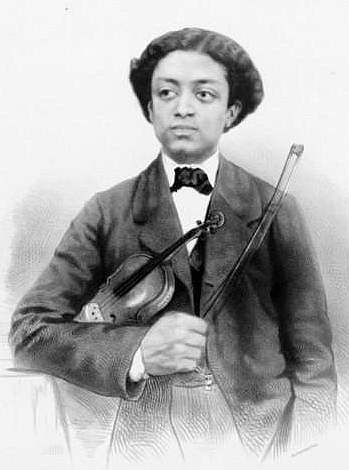Home
Blog
Composers
Musicians
Black History
Audio
About Us
Links
Composers:
Adams, H. Leslie
Akpabot, Samuel Ekpe
Alberga, Eleanor
Bonds, Margaret Allison
Brouwer, Leo
Burleigh, Henry Thacker
Coleridge-Taylor, Samuel
Cunningham, Arthur
Dawson, William Levi
Dede, Edmund
Dett, R. Nathaniel
Elie, Justin
Ellington, Edward K. "Duke"
Euba, Akin
Garcia, José Mauricio Nunes
Hailstork, Adolphus C.
Holland, Justin
Jeanty, Occide
Johnson, James Price
Joplin, Scott
Kay, Ulysses Simpson
Khumalo, Mzilikazi
Lambert, Charles Lucien, Sr.
Lambert, Lucien-Leon G., Jr.
Lamothe, Ludovic
Leon, Tania
Moerane, Michael Mosoeu
Perkinson, Coleridge-Taylor
Pradel, Alain Pierre
Price, Florence Beatrice Smith
Racine, Julio
Roldan, Amadeo
Saint-Georges, Le Chevalier de
Sancho, Ignatius
Smith, Hale
Smith, Irene Britton
Sowande, Fela
Still, William Grant
Walker, George Theophilus
White, José Silvestre
Williams. Julius Penson
AfriClassical Blog
Companion to AfriClassical.com
Guest Book
William J. Zick, Webmaster,
wzick@ameritech.net
©
Copyright 2006-2022
William J. Zick
All rights reserved for all content of AfriClassical.com
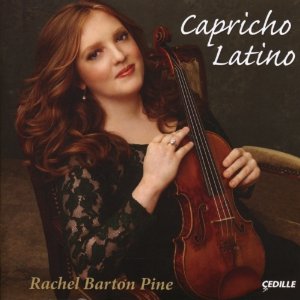
Capricho Latino
Etude No. 6 (a Secundino Arango) 5:11
Rachel Barton Pine, Violin
Cedille CDR 90000 124 (2011)
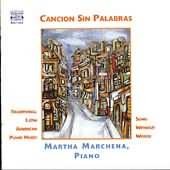
Cancion Sin Palabras
La bella Cubana
Martha Marchena, piano
MSR 1054 (2002)
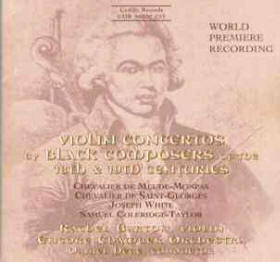
Violin Concertos by Black Composers of
the 18th & 19th Centuries
Violin Concerto in F-sharp Minor (21:24)
Rachel Barton, violin
Encore Chamber Orchestra
Daniel Hege, Conductor
Cedille Records 90000 035 (1997)
|
Home ->
Composers -> White, José Silvestre
Français
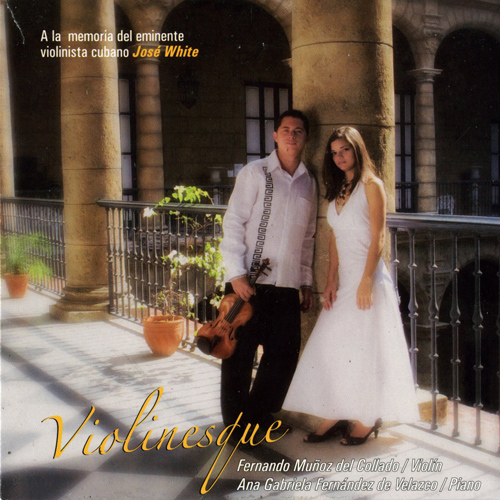
José White: Violin and Piano
Music (Violinesque) Fernando Munoz del Colado, violin; Ana
Gabriela Fernandez de Velazco, piano;
ColibriCD-198
"A la
memoria del eminente violinista cubano José White"
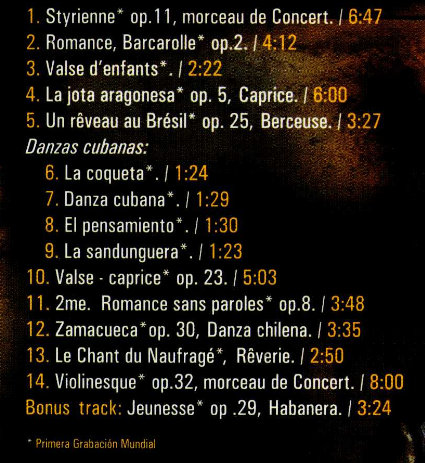
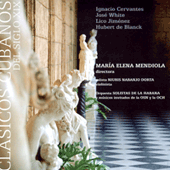
Clasicos Cubanos del Siglo XIX
Orquesta Solistas de La Habana
y músicos invitados de la OSN y la OCH
directora Maria Elena Mendiola
solista Niuris Naranjo Dorta, violinista
ColibriCD-117
[Cuban Classics of the 19th Century
Soloists Orchestra of Havana
and Guest Musicians of the NSO and OCH
Maria Elena Mendiola, Director
Niuris Naranjo Dorta, Violin Soloist
Colibri CD-117]
1- Scherzo caprichoso
4:50
Ignacio Cervantes
2- A la memoria de Antonio Maceo
7:00
Canto fúnebre
Hubert de Blanck
Concierto en fa
sostenido menor
22:10
para violin y orquesta
[Violin Concerto in F-sharp Minor]
José White
solista Niuris Naranjo Dorta
3- Allegro
12:12
4- Adagio ma non troppo
4:50
5- Allegro moderato
5:00
6- Estudio sinfonico
7:00
José Manuel "Lico" Jiménez
1 Birth
José Silvestre White, aka
José Silvestre White y Lafitte, was an Afro-Cuban composer,
violinist and professor. His mother was Afro-Cuban and his
father Spanish. Josephine Wright, Professor of Music at the
College of Wooster, in Wooster, Ohio has published an article
Violinist José White in Paris, 1855-1875, in Black Music
Research Journal, Vol. 10, No. 2, Fall 1990. She outlines
White's early training in music:
|
According to Argote (1953, 83) the violinist
was born José Silvestre White y Lafitte in
Matanzas, Cuba, on December 31, 1835.
Exhibiting considerable musical talent as a
child, he was given his earliest musical
training by his father, Don Carlos White, who
was an amateur violinist. Violin lessons
continued in Cuba during his adolescent years
with José Miguel Roman and Pedro Lecerff(Stevenson 1975, 2), and the young violinist
gave his first public concert iin Matanzas on
March 21, 1854. On that occasion he
performed a fantasy on themes from Rossini's William Tell by Osborne and Bériot and two
pieces of his own composition, variations on
themes from The Carnival of Venice and Melodia sobre aires cubanas (Ramirez 1891,
176; Stevenson 1975, 2). His accompanist
was the famous North American pianist-composer Louis Moreau Gottschalk (1829-1869), who encouraged him to pursue further
violin studies in Paris and raised money for
him to travel there (Stevenson 1975, 2)
|
2 Paris Conservatory
Professor Wright tells us José White first lived in Paris during
his days as a student at the Paris Conservatory:
|
White's earliest association with the city of
Paris dates from about 1855, when he was
admitted to the Paris Conservatory as a
student, following an audition with sixty rival
candidates and the unanimous
recommendation of his faculty jurors (Trotter
[1878] 1986, 225). At the conservatory he studied violin with Jean-Delphin Alard, the pre-eminent master of the French school of violin
playing; harmony, and presumably
composition, with composer Henri Reber (1807-1880); and counterpoint and fugue with
Ferdinand Taite (Argote 1953, 88). He was
exposed as well to the considerable richness
of concert music, virtuoso performers, and
influential composer-musicians that this
teeming metropolis had to offer a talented
young music student in the 1850s. |
3 First Grand Prize
The article tells of José White's success at the Paris
Conservatory, as evidenced by his First Grand Prize in Violin:
|
Thriving in such an enriching, stimulating
environment, José White excelled. After just
one year of study, he won the Paris
Conservatory's highest award in violin, the coveted First Grand Prize. That competition
took place on July 29, 1856, and was reviewed
by Le Pays on August 5:
"The competition for violin [at the
Conservatory] has offered a beautiful spectacle
this year, being the most brilliant struggle.
The first grand prize was conceded to Mr.
White, pupil of Alard, and the second [prize] to
Mr. [Aimé] Gros, from the same class... Mr.
White showed himself [so] superior that there
should have been created a grand exceptional
prize in his favor. He performed with an
extraordinary animation, not like a pupil but as
a great artist who commands his audience.
The jury itself was electrified" (Ramirez 1891,
178). |
4 Professional Ties
Josephine Wright describes the valuable professional ties José
White established with musicians in Paris while he studied at
the Paris Conservatory:
|
Although many other details about White's
years at the conservatory are fragmentary,
there exists evidence that he developed strong
ties with members of the musical community
in Paris and cultivated friendships that would
later serve him well during the 1860s and
1870s when he began to concertize
professionally. We know, for example, of his
introduction to the musical circle of Félicien
David and his friends through a letter written to
the violinist by Giacchino Rossini (J.M.G.Z.1874, 4).
To Mr. White
Sir:
Allow me to express to you all the
pleasure that I felt Sunday last at the home of
my friend Mr. David. Your warm execution,
feeling, elegance, the brilliance of the school
to which you belong, are qualities in an artist
like you of which the French school can be
proud.
May it be, Sir, [that] with my sympathetic
wishes I bring you good fortune by finding in
good health the one for whom you fear today.
Accept my blessings. I wish you a
happy journey and a safe return.
Giacchino Rossini
Paris, November 28, 1858 |
5 Illness of Father
The author explains Rossini's references to illness and travel
in a footnote to the article:
|
The crisis to which Rossini's letter alludes
pertained to a serious illness of the young
violinist's father, which necessitated his
immediate departure from Paris for Cuba.
White apparently remained in Cuba through
March 1860 and gave concerts throughout the
island during this period. He returned to Paris shortly thereafter and resumed his studies at
the conservatory (Argote 1953, 93-94;
Stevenson 1975, 2). |
6 Concerts in 1861
Prof. Wright writes that four concerts in Paris in 1861
brought José White to the attention of the public:
|
Also during his conservatory years, White
participated in four public performances in
1861 that attracted considerable attention from
the Parisian press and seemed to mark a
turning point in his career; (1) his full-length recital with orchestra at the conservatory
during April of that year (J.M.G.Z. 1874, 9); (2)
his concert with orchestra at Salle Herz on
April 11 (Le Ménestrel April 7, 1861); (3) his
collaboration on the concert of pianist A.
Mansour at Salle Pleyel on April 15 (LeMénestrel April 7, 1861); and (4) his performance of a new quintet by C. Estienne
on a matinee concert organized during
December by pianist Casimir Ney, who would
later perform chamber music professionally with
White during the late 1860s and early 1870s
(Le Ménestrel December 29, 1861). |
7 Six Etudes
CedilleRecords.org
says of the CD Capricho Latino, Cedille CDR 90000 124
(*2011):
|
Violinist Rachel Barton
Pine, Cedille Records' all-time best-selling artist, has
created another rare - perhaps unique - contribution to
the world's CD catalog: an album of Spanish and Latin
American music written solely for unaccompanied violin. |
Rachel Barton
Pine writes in the liner notes of Capricho Latino:
|
Each of White's Six
Etudes (1868) is dedicated to a famous violinist:
his teacher Alard, Ernesto Camillo Sivori, Henri
Vieuxtemps, Henryk Wieniawski, Hubert Leonard, and one
Secundino Arango, whose identity has intrigued European
and American scholars. Arango, Afro-Cuban, born in
Havana at the end of the 18th century and deceased in
the same city in the late 1840's, was a violinist,
cellist, organist, and composer of both religious music
and popular danzones. He was also White's first violin
teacher. Fittingly, White's Etude No. 6 is a
danzón with a pyrotechnic central section much in
the virtuoso Parisian style of the time.” |
8 Tour of the Americas
José White made a performance tour of the Americas from
1875-1877. Josephine Wright lists the places at which he played,
during the tour, in the United States:
|
White appeared twice as guest soloist with
the New York Philharmonic under Theodore
Thomas during the 1875-1876 season and
gave additional concerts in the greater New
York area. He also gave concerts in Boston,
Washington, and Philadelphia (Argote 1953,
96). |
9 Final Years
Prof. Wright tells us José White served as director of the
Imperial Conservatory in Rio de Janeiro, Brazil from 1877 to
1889, when she reports he returned to live in Paris until his
death:
|
He returned to Paris during the winter of 1889
and resided there until his death in 1918... |
10 Surviving Works
Gordon Root gives an overview of White's surviving sheet music
in Africana Encyclopedia:
|
Many of his works still survive today, including
a concerto, a string quartet, a collection of
studies for violin, and several nationalistic
pieces such as Marcha cubana, and perhaps
his most famous composition, the habanera
(a Cuban dance in slow duple time) La Bella
cubana. |
11 Catalogue
A full catalogue of José White's surviving compositions has been
compiled by Dominique-René de Lerma, Professor of Music at
Lawrence University. It is found in the same issue of Black
Music Research Journal as Prof. Wright's article. The catalogue
of editions, performances, recordings and collections includes
these titles, among others:
|
La Bella cubane: The bay of Naples (violin
and piano). Paris: Ch. Hayet, 1910. 7pp.
Recorded: Columbia CL-773.
Concerto for violin and orchestra in F-sharp
minor. 1864. Bibliothèque Nationale.
Concerto for violin and orchestra in F-sharp
minor. Edited by Paul Glass and Kermit
Moore. Premiere: February 24, 1974; Avery
Fisher Hall, New York; Ruggero Ricci, violin;
Symphony of the New World; Kermit Moore,
conductor. Recorded: Columbia M-33432
(Aaron Rosand, violin; London Symphony
Orchestra; Paul Freeman, conductor).
Library: Library of Congress.
Hélas: Valse lente. Paris: Durdilly, 1907.
Library: Bibliothèque Nationale.
Marcha cubana (piano). 1909. Dedication:
Ignacio Cervantes.
Six grandes études, op. 13 (violin,
unaccompanied). Paris: Schonenberger, 1869.
Library: Bibliothèque Nationale. |
12 Recordings
One recording of the music of José White is Violin Concertos By
Black Composers of the 18th and 19th Centuries, Cedille 90000
035 (1997), which includes his Violin Concerto in F-sharp Minor
(21:34) performed by Rachel Barton, violin and the Encore
Chamber Orchestra led by Daniel Hege, Conductor.
Another CD is Cancion Sin Palabras, MSR 1054 (2002). José White
is represented by La Bella Cubana, performed on piano by Martha
Marchena. A third is Capricho Latino, Cedille
CDR 90000 124 (2011), the recording by violinist Rachel Barton
Pine which is discussed above,
13 Website
The IberoAmerica Ensemble is made up of five classically trained
musicians who perform classical and popular works with Hispanic
and Latin American origins. The members are Ana Ruth
Bermudez, cello; Danielle Pardo, viola;
Rene Izquierdo, guitar; JoAnn Haasler, violin; and Karl Orvik,
violin. The ensemble's Website features audio and video
versions of La Bella Cubana:
http://www.iberoamericamusic.com/repertoire/bella-cubana-jose-white.html
This page was last updated
on
March 5, 2022
|




